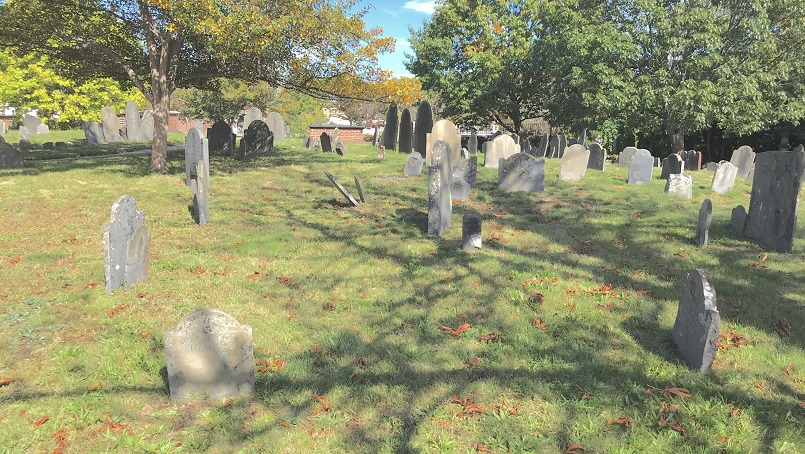
31 Oct 2017 More Than Halloween: Boston’s Historic Burying Grounds Express the City’s Long and Rich History
For the month of October, HBI has been introducing our Facebook and Instagram friends to the extraordinary art and history in the Eliot Burying Ground next door to our office at 20 Eustis St in Roxbury. The burying ground is the oldest cemetery in Roxbury, dating back to 1630 and is the final resting place of many well known Bostonians such as colonial leaders Thomas and Joseph Dudley, the Reverend John Eliot, and clockmaker Aaron Willard.
Currently there are three active and sixteen historic cemeteries in Boston, each one with its own unique history. Copp’s Hill (1630), in the North End, for instance is the final resting place of over 10,000 people with 1,000 being enslaved or freed African Americans, including the early abolitionist and freemason Prince Hall. In East Boston’s, Bennington Street Burying Ground (1841) eleven legible stones are written in German, which reflects the changing demographics of that neighborhood in the 19th century. Most famously, patriots Samuel Adams, John Hancock, Paul Revere and the five victims of the Boston Massacre – among many other early Bostonians – rest in the Granary Burying Ground downtown.
Adjacent to HBI’s project at the Upham’s Corner Comfort Station is the Dorchester North Burying Ground, which has perhaps the greatest variety of gravestone designs and materials. It contains examples of funerary sculpture from the seventeenth, eighteen, nineteenth, and twentieth centuries, resulting in a very interesting mix of colors, shapes and sizes. Additionally for the first two hundred years of its existence the burying ground was without trees or vegetation. In 1834, early landscape designer Samuel Downer designed a new l landscape for this cemetery. He created a system of pathways and avenues named after prominent Dorchester families. Over 400 shade trees and rare specimen trees were planted and a large number of shrubs and floral displays were also planted, giving the burying ground an arboretum-like atmosphere.
Over the course of Boston’s history and development, many of the original markings and resting places have been moved or no longer exist. The orderly rows of gravestones in the downtown Boston graveyards of Granary, King’s Chapel, Central and Copp’s Hill, are thought to be 19th century alignments and adjustments to allow for better maintenance and mowing. And then there are the natural development changes of the city around each of these fragile environments. During the 2011 restoration of the Eustis Street Firehouse, HBI worked alongside the Boston Parks and Recreation Department and the City Archeologist to ensure a safe and respectful renovation of the former fire house structure which was built into the burying ground in 1859.
Are you interested in visiting the Eliot Burying Ground? Stop by our office at 20 Eustis Street during business hours, and we will gladly grant you access.



